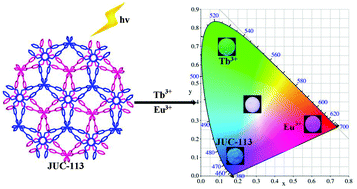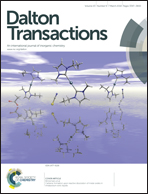Tunable colors and white-light emission based on a microporous luminescent Zn(ii)-MOF†
Abstract
Metal–organic frameworks (MOFs) are a rapidly growing class of hybrid materials with many multifunctional properties. The permanent porosity plays a central role in the functional properties. In particular, the luminescent MOFs with a permanent porosity have wide applications in guest species recognition and adsorption. In this contribution, we aim to develop tunable colors and white-light luminescence materials by the encapsulation of Ln3+ species in microporous luminescent MOFs. A semi-rigid trivalent carboxylic acid 1,3,5-tri(4-carboxyphenoxy)benzene (H3TCPB) was selected as the organic building block, not only because it is suitable to construct microporous frameworks, but also by reason of its blue luminescent emission. Under solvothermal reactions, a microporous MOF material, [Zn3(TCPB)2(H2O)2]·2H2O·4DMF (JUC-113, JUC = Jilin University, China), was synthesized, which has a permanent porosity and emits blue light. According to three-primary colors, the guest luminescent species should be Tb3+ and Eu3+ owing to their distinctive colors (Tb3+, green; Eu3+, red). In addition, the luminescent properties of JUC-113 can be easily tuned by different combinations of the encapsulation amount of Tb3+ and Eu3+, obtaining white-light emission materials.


 Please wait while we load your content...
Please wait while we load your content...